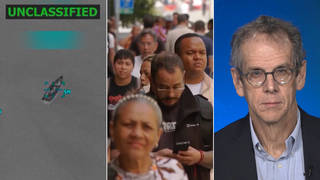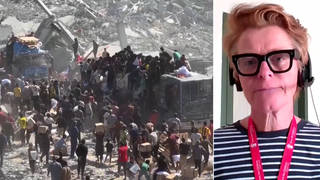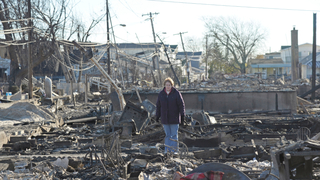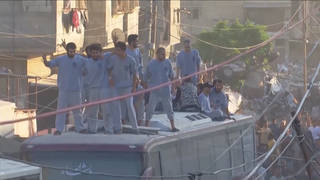
Topics
Guests
- Justin Elliottreporter for ProPublica and one of the lead authors of their new investigation, “The Red Cross’ Secret Disaster.” The investigation was produced with NPR, and the second part aired today on Morning Edition.
- Richard Rieckenbergformer disaster expert with the Red Cross. He oversaw aspects of the Red Cross’ efforts to provide food, shelter and supplies after the 2012 storms.
This week marks the second anniversary of Superstorm Sandy hitting the New York City region, becoming one of the most destructive storms in the nation’s history. A new joint investigation by ProPublica and NPR contends the American Red Cross bungled its response to Superstorm Sandy by caring more about its image and reputation than providing service to those in need. It alleges the organization diverted vehicles and resources to press conferences instead of using them to deliver services. And it estimates the Red Cross wasted an average of 30 percent of the meals it was producing in the early days of its Sandy response effort. We speak to ProPublica reporter Justin Elliott and Richard Rieckenberg, former disaster expert with the Red Cross — he oversaw aspects of the organization’s efforts to provide food, shelter and supplies after the 2012 storms. We also air an official Red Cross response to their investigation.
Transcript
NERMEEN SHAIKH: This week marks the second anniversary of Superstorm Sandy hitting the New York region, becoming one of the most destructive storms in the nation’s history. After first pummeling Cuba, Jamaica and the Dominican Republic, Sandy made its way up the East Coast. On October 29th, the hurricane blasted New York City with a record storm surge as high as 13 feet. The storm also heavily hit the Jersey Shore and parts of New England. Sandy ultimately killed 159 people along the East Coast and damaged more than 650,000 homes. The storm caused $70 billion in damage across eight states. Millions were left without power, some for weeks.
Well, a new investigation by ProPublica and NPR says there were actually two disasters during Sandy: the hurricane itself and the ensuing relief effort by the Red Cross. This is a clip from a video accompanying the investigation headlined “The Red Cross’ Secret Disaster.”
LAURA SULLIVAN: It’s October 2012. Superstorm Sandy barrels up the Eastern Seaboard from Florida to Maine. The storm leaves millions in the cold and dark. Dozens die. A star-studded relief effort helps the Red Cross rake in more than $300 million in donations. This is the untold story of that Red Cross relief effort, how one of the nation’s most revered charities bungled its mission and misled the public.
GAIL McGOVERN: I think that we are near flawless so far in this operation. I’m just so proud of everything that we are doing on the ground. It is incredible.
LAURA SULLIVAN: But confidential documents and insider accounts paint a different picture.
RICHARD RIECKENBERG: They lost confidence in their ability to do the right thing, and so they did the next best thing, which is, what can we do to make people think that we’re doing the right thing?
NERMEEN SHAIKH: That was a clip from a video accompanying the new joint investigation by ProPublica and NPR called “The Red Cross’ Secret Disaster.” The report contends that the American Red Cross bungled its response to Superstorm Sandy by caring more about its image and reputation than providing service to those in need. It alleges the organization diverted vehicles and resources to press conferences instead of using them to deliver services. And it estimates the Red Cross wasted an average of 30 percent of the meals it was producing in the early days of its Sandy response effort.
AMY GOODMAN: Well, for more, we’re joined now by two guests. Here in New York, Justin Elliott, reporter for ProPublica and one of the lead authors of their new investigation, “The Red Cross’ Secret Disaster.” And in Santa Fe, New Mexico, Richard Rieckenberg joins us, former disaster expert with the Red Cross who oversaw aspects of the organization’s efforts to provide food, shelter and supplies after the 2012 storms.
We welcome you both to Democracy Now! Justin Elliott, just lay out your findings.
JUSTIN ELLIOTT: Sure. So, this investigation is based, as you mentioned, on the Red Cross’s internal documents, some of their after-action reports, emails from the time, and also interviews with a lot of officials that were involved in the Sandy response, as well as victims in New York and New Jersey. And we found, first of all, that the Red Cross botched the key elements of its mission to provide relief after the storm. And I think most disturbingly, we found that one of the reasons for that was that the Red Cross’s leadership has become so obsessed with burnishing the brand and public relations that it’s actually undermined the disaster relief efforts and undermined some of the people on the ground, like Richard, who were trying to, you know, actually accomplish the mission of delivering aid.
NERMEEN SHAIKH: Well, could you give us an example of how it is that the Red Cross diverted resources to maintain its image or for public relations purposes, rather than providing resources to those in need?
JUSTIN ELLIOTT: Sure. So, one example, after Sandy hit New York a couple years ago, several officials on the—Red Cross officials on the ground told us that there were issues where the Red Cross’s emergency response vehicles, which are sort of these van truck vehicles where there’s a window and they’re used to deliver food and relief items to people in affected areas, were diverted by leadership to instead be backdrops at press conferences and in photo ops. And this was done at a level that was actually hurting the relief effort. And this is not just drawn from accounts of people at the time. We also published on ProPublica a “Lessons Learned” presentation by the Red Cross, where there’s a slide that says, “hindrances to service delivery,” and the first bullet point is national headquarters. And then, under that, it says national headquarters was “diverting assets for public relations purposes.”
AMY GOODMAN: You talked about the Hurricane Isaac even before Sandy, the two of them, when Red Cross ordered 80 trucks and emergency response vehicles to leave the lot empty, drive around Mississippi, to make it look like they were doing something.
JUSTIN ELLIOTT: That’s right. We’ve talked to multiple people who either observed or actually took part in that incident. I spoke with one of the emergency response vehicle drivers, who is a volunteer, like most Red Cross workers, had driven from North Carolina to respond to Isaac, which hit the Gulf Coast a couple months before Sandy, and told me that the Red Cross effort was actually worse than the storm. And in particular, there was this incident where he was told to take his emergency response vehicle out and just drive around to make it look like they were doing something.
AMY GOODMAN: Well, yesterday Democracy Now! spoke with Laura Howe, vice president of public relations for the American Red Cross. We asked her if the Red Cross diverted these vehicles and resources to press conferences, like, you know, Heidi Klum, in Staten Island to be the backdrop instead of using them to deliver services. This is how she responded.
LAURA HOWE: This is just patently untrue. The Red Cross didn’t host any press conferences during the first month of Sandy. We participated in a limited number of press events that were hosted by other people. Most of those took place for about 15 minutes or so. And the important thing to remember is they took place in places where service delivery was already happening, so our trucks were already there, our people were already there, and there were—there was a response happening in those locations. So, we had hundreds of requests from media outlets to see our services. And part of what we have to do is inform the public about how to get help from us. And so, it stands to reason that we would do that.
AMY GOODMAN: That’s Laura Howe, vice president of public relations for the American Red Cross. Again, we had hoped that she would be on with our guests today, but they refused. We’re also joined by Richard Rieckenberg, the former disaster expert with the Red Cross who oversaw aspects of its efforts to provide food during the—after the storms. Your response to the Red Cross, Richard Rieckenberg?
RICHARD RIECKENBERG: Response specifically to what? What Laura Howe said?
AMY GOODMAN: Yes.
RICHARD RIECKENBERG: I think I can understand Laura’s position, that public relations is important. The issue that I saw in Isaac and Sandy, for the first time that I worked with the Red Cross, is that public relations became more important than mass care. I like to paraphrase something that Bob Scheifele said, who’s the senior mass care chief in the country: Is it more important to feed a person or more important to tell the world that you fed a person? And Sandy was my 26th disaster relief operation, and Isaac and Sandy were the first time that I worked with the Red Cross that I felt it was more important for the Red Cross to tell the world they fed a person than it was to feed them.
NERMEEN SHAIKH: Richard Rieckenberg, what do you think accounts for this change in the focus of the work of the Red Cross? It was the 26th—Sandy was the 26th emergency operation that you worked for with the Red Cross, and Isaac and Sandy were the first times that you witnessed this emphasis on public relations rather than the provision of services. What accounts for the shift?
RICHARD RIECKENBERG: I think a couple of things. I think the restructuring of the Red Cross really hurt the ability of the Red Cross to do disaster relief. They had been closing down a lot of the small local chapters around the country. And when you start to do that, consolidating them into bigger chapters and also consolidating resources in Washington, D.C.—when you start to do that, you start to lose your expertise and your contact with the local community, and you start to lose the volunteers who have got a lot of experience in disaster relief. I think—
AMY GOODMAN: Well, let me go back to Laura Howe, the spokesperson, who talked directly about you, Richard Rieckenberg, saying you had “a very limited view” of the Red Cross’s response to Hurricane Sandy.
LAURA HOWE: Mr. Rieckenberg was one of 79 chiefs that served in a similar role on the Sandy operation. So, given that, he had a very limited view of the operation, and that limited view lasted just a few weeks. So he reported into a much larger, much broader chain of command, and the people above him, the people that spoke to ProPublica and spoke to NPR on the record on behalf of the Red Cross, had a much, much broader view of what was happening within the organization.
AMY GOODMAN: That was Laura Howe of the Red Cross. Richard Rieckenberg, your response?
RICHARD RIECKENBERG: Well, my response is that I was the mass care planning chief, first in Washington, D.C., and then I decided to go to New York City. As such, I was the senior mass care person at the scene. Laura is right in that I can only speak about mass care. But mass care is the bulk of what the Red Cross did, the bulk of what they do for all—for the beginning of all disasters. And so, the bulk of the Red Cross workers there are mass care workers, and I’m the one that was planning the mass care efforts.
AMY GOODMAN: Justin Elliott?
JUSTIN ELLIOTT: I just want to make a point here. I mean, I just think it’s sad that the Red Cross’s position here is trying to sort of cast doubt on Richard’s accounts. I mean, first of all, the point that he makes is obviously true. Our reporting shows that he was a high-level person responding to both Isaac and Sandy. But also, everything we reported that Richard told us was confirmed by other officials, and in almost all cases is actually also corroborated by Red Cross documents, that we encourage people to look at on our website at ProPublica. I mean, again, there is a Red Cross—it’s called a “Lessons Learned” presentation, that says, “a hindrance to service delivery,” national headquarters diverting aid, diverting disaster relief assets, like trucks, “for public relations purposes.” So, again, that’s in black and white, a Red Cross document that came out of headquarters. And as we were doing our reporting and interviewing Richard and several other officials who were on the ground, they all said that that was totally true.
And one point on the press conference is, there’s actually pictures of the CEO of the Red Cross, Gail McGovern, giving—participating in a press conference out on Staten Island a few days after Sandy, again, published on our website, where you can see in the background emergency response vehicles being used as backdrops, just like Richard says. And one other point, since the story was published yesterday, I’ve since heard from another person who was involved in that effort who confirmed the entire account that we published, which we already knew was true, but, I mean, yeah.
AMY GOODMAN: Talking about the CEO, McGovern, she went on NBC and said the Red Cross’s response was “near flawless” to Sandy. Talk about your meeting minutes that you got from the Red Cross.
JUSTIN ELLIOTT: Right. I mean, this, in some ways, was kind of one of the most shocking things we found in the course of our reporting. As you mentioned, about two or three weeks after Sandy, the CEO of the Red Cross, Gail McGovern, went on national television, NBC, because there were some questions sort of anecdotally on the ground of sort of “Where was the Red Cross?” And she said, our response effort so far has been, quote, “near flawless.”
Just a few weeks later, there was a meeting of Red Cross executives, at the sort of vice-president level, which is the highest position in the organization below CEO, and they’re just painting a totally, starkly different picture, saying things like—and again, we published this—”We didn’t have the sophistication for this size job,” “multiple systems failed,” you know, our “biggest challenge” is the “skillset … possessed by our workforce,” which gets at something that Richard mentioned, which was—I mean, sort of a little bit of a backstory here—there’s been restructurings and layoffs in recent years, and a lot of experienced disaster responders have left. So, the sort of public version of what happened, that was given by the CEO, compared to just a couple weeks later, the behind-closed-doors version, were just utterly at odds with each other.
NERMEEN SHAIKH: And, Richard Rieckenberg, when you first noticed the failings of the Red Cross while you were still employed there, you raised some of your concerns with your colleagues and your superiors. Could you explain what you did and what kind of response, if any, you received?
RICHARD RIECKENBERG: Yes, I was very upset about the response to Hurricane Isaac, because I think we made some very important decisions that were fundamentally against our principles. I mean, in my mind, they were fundamentally immoral decisions. Bob Scheifele and I—I was, with Hurricane Isaac, in Florida, and then I went to Mississippi, where we really weren’t prepared for a hurricane that we should have been very easily prepared for. So Bob Scheifele, who was in Louisiana, and I contacted the vice president of the Red Cross, Trevor Riggen. I sent him an email, and I sent him my travel report from Mississippi and Florida and said that we’re very upset about what we saw there, and we asked to meet with him and two other vice presidents in Washington, D.C., which he agreed to do. So we ended up flying to Washington, D.C., in October and presenting him with our concerns.
AMY GOODMAN: This goes back to—I mean, it can go back before, but, Justin Elliott, for example, Hurricane Katrina. What was the Red Cross’s response there? And what ultimately most shocked you in your reporting?
JUSTIN ELLIOTT: Sure. I mean, the Red Cross has had a tough past sort of decade and a half. There were scandals involving financial mismanagement after—actually, after September 11th, when they raised a lot of money, I believe over a billion dollars, and then after Katrina. One interesting thing about the Red Cross is it’s actually created by Congress, so there’s some congressional oversight, and Congress actually forced an overhaul after Katrina. The new CEO, Gail McGovern, was brought in a couple years after Katrina, and sort of publicly it seemed like things had stabilized a little bit. But, I mean, just in general, the thing that sort of was most surprising is that behind the scenes, again, talking to many, many officials, who either used to or currently work at the Red Cross, have lost faith in the leadership. And part of that has to do with sort of basic issues of competence in responding to disasters, but part of it also has to do with the sort of values of the management, that at this point seem to prioritize public relations and sort of the brand above the actual hard work of disaster—
AMY GOODMAN: They get $300 million from one superstar concert. And you have Occupy Sandy. Talk about that, the offshoot of Occupy Wall Street—
JUSTIN ELLIOTT: Right.
AMY GOODMAN: —and what happened on the ground with people who had almost nothing.
JUSTIN ELLIOTT: Right, so, I mean, the $300 million is actually the Red Cross’s overall fundraising for Sandy, part of which was from this celebrity concert. But yeah, there were some volunteer sort of groups, including Occupy Sandy, which was a sort of offshoot of Occupy Wall Street, that sprang into action after Sandy. And some of those people are quoted in my piece, where those groups were, for example, in the Rockaways, one of the most devastated areas out in Queens, and they didn’t really see the Red Cross until a couple weeks after the storm. So, you know, and they were sort of operating on a shoestring budget.
I mean, I think one of the reasons we thought that this was so important to do is, as you say, when there’s a big disaster, most Americans, you know, they’re seeing these terrible images on their television screen, and they want to do something, and they give money to the Red Cross. And to be clear, you know, I believe that it’s an incredibly important institution, and there’s a lot of good people that have worked there and do work there, like Richard, who are trying to—who are real experts who are trying to do disaster relief. So, it’s very unfortunate that a lot of—you know, a lot of that money was squandered.
AMY GOODMAN: We want to thank you very much, and we’ll certainly link to your reports at ProPublica, Justin Elliott, reporter for ProPublica and one of the lead authors for this new investigation, “The Red Cross’ Secret Disaster.” Richard Rieckenberg, thanks so much also for joining us, former disaster expert with the Red Cross who oversaw aspects of the Red Cross efforts to provide food, shelter and supplies after Hurricanes Isaac and Sandy. He was speaking to us from Santa Fe, New Mexico.
This is Democracy Now! When we come back, money in judicial elections. Stay with us.












Media Options